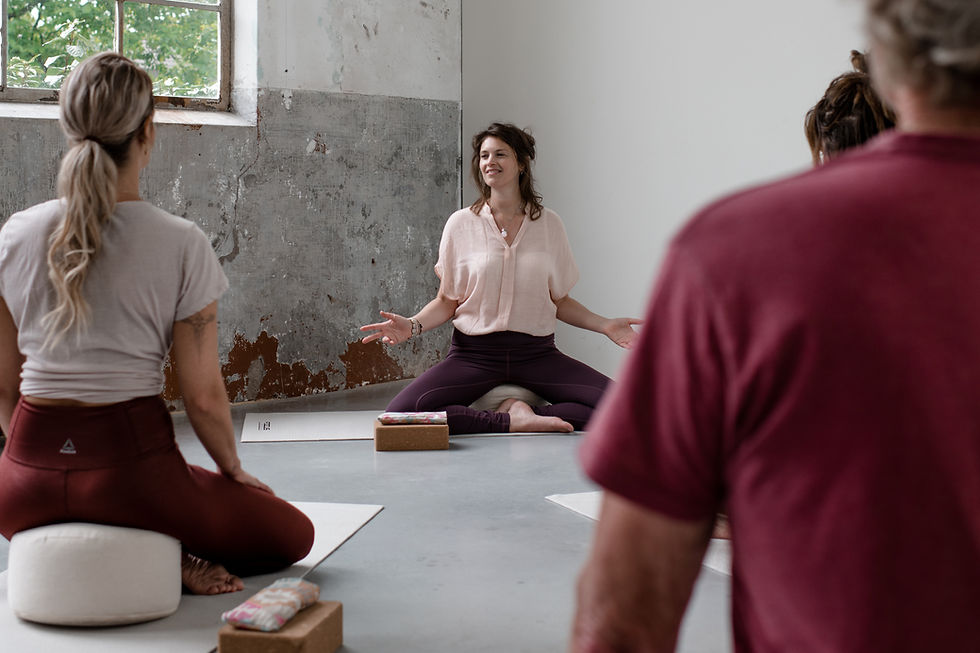Startup Yoga - why?
During yoga you rest and recover. Yoga thus as an antidote against stress [1]. Insufficient time and opportunities to recover from stress is what makes stress a problem [2].
Yoga also provides more focus, creativity and productivity. And of course a good vibe in the workplace!
For those who are not yet convinced, below is a selection of the many scientific studies about the positive effects of yoga.
Yoga against stress and burnout
Chronic stress leads to a poorer memory and reduced concentration, decision-making, social interaction and the production of new brain cells, less and less ability to deal with stress, an increase in anxious thoughts and even the risk of depression.
Yoga (mediation in movement) is a proven effective remedy for stress [3].
And a remedy for (chronic) stress is desperately needed. Stress at work has been the number one occupational disease for years. In 2020 1.2 million employees in the Netherlands suffered from burnout complaints (that is 16% of the working population). Absenteeism costs per employee in 2019 amounted to EUR 3.2 billion (average EUR 9,300 per employee) [4].
Yoga improves mental brain functions
Yoga contributes positively to mental brain functions, both memory and the regulation of emotions. Through a combination of exercise, meditation and breathing exercises, fearful thoughts decrease and positive feelings increase [5].
The same goes for practicing mindfulness. Observing thoughts and learning to direct attention is part of every yoga class. By applying mindfulness, your mind becomes calmer and you are less reactive. You can concentrate and relax better, you also pick up signals of stress sooner [6].
Yoga as a means to connect with each other
There is a measurable emotional connection between people and more specifically their hearts. Each heart produces an electromagnetic field up to 4 meters that communicates with the magnetic field of another heart. By paying attention to meditation, breathing and relaxation during a yoga class, a powerful and positive magnetic field is created. Joint connection is created, oxytocin (also called the cuddle hormone) is produced and you literally charge each other [7].
Yoga improves sleep [8]
Yoga reduces migraines [9]
Yoga is effective for (chronic) pain complaints and low back pain [10]
Yoga has a beneficial effect on the immune system, increased blood pressure & lifestyle disease type 2 diabetes [11]














[1] During a yoga class you positively influence your autonomic nervous system and calm the limbic system.
The autonomic nervous system consists of two opposite parts.
The sympathetic part focuses on surviving, fighting, fleeing and performing (under stress). With the help of adrenaline and cortisol, among other things, your heart rate, blood pressure and breathing rhythm increase. Body functions that are not necessary for 'survival' are switched off, such as digestion, but also the part of the brain that is responsible for planning and considering.
The parasympathetic part focuses on rest, relaxation and recovery. With the help of serotonin, melatonin and oxytocin, among other things, your heart rate, blood pressure and breathing rhythm decrease. Yoga focuses on "turning on" the parasympathetic part, which makes you better able to withstand stress, sleep better, your brain works better (better memory), regulate emotions better, improve your immune system and you are better able to socialize. Interaction.
The limbic system, also called the mammalian brain, is a group of brain structures that are involved in motivation and the regulation of emotions, among other things. During yoga this area is stimulated and also calmed by relaxing at the same time. New neurological pathways are then created in the brain, so that emotions can be regulated better and better.
[2] A famous saying by Tal Ben-Shahar, Harvard professor and author of several bestselling books on positive psychology, mindfulness and leadership.
[3] This short TED talk shows what (chronic) stress can lead to and that yoga (mediation in movement) is a remedy for stress . This is confirmed by the Dutch Brain Foundation and the studies published in the Journal of Psychophysiology (2017) and the Psychoneuroendocrinology (2017).
[4] _cc781905-5cde-3194- bb3b -136bad5cf58d_TNO research shows that stress at work has been the number one occupational disease for years. It follows from the TNO factsheet 'work stress' that in 2020 1.2 million employees in the Netherlands suffered from burnout complaints (16% of the working population). The cost of absenteeism per employee in 2019 amounted to EUR 3.2 billion (average EUR 9,300 per employee).
[5] Yoga improves mental brain functions according to studies in ' Brain Plasticity ' (2019), ' International Journal of Yoga ' (2018) and ' The Journal of Alternative and Complementary Medicine ' (2010)._cc781905-5cde-3194-bb3b -136bad5cf58d_
[6] Mindfulness also improves mental brain function, according to research from the University of Wisconsin (2003).
[7] Research by the ' HeartMath Institute ' shows that there is a measurable emotional connection between people and more specifically their hearts. By paying attention to meditation, breathing and relaxation during a yoga class, a powerful and positive magnetic field is created. Yoga is thus a means of connecting with each other.
[8] Yoga improves sleep according to research in ' Applied Psychophysiology and Biofeedback ' (2004).
[9] Yoga reduces migraines according to research in ' The Journal of Head and Face Pain ' (2007).
[10] Yoga is effective for (chronic) pain and low back pain, according to research in ' Annals of Internal Medicine ' (2017).
[11] Yoga has a beneficial effect on the immune system, increased blood pressure & lifestyle disease type 2 diabetes , according to studies in PLOS ONE (2013), ' Diabetology & Metabolic Syndrome ' (2015 ) and ' Journal of Clinical and Diagnostic Research'_cc781905-5cde -3194-bb3b-136bad5cf58d_ (2015).


